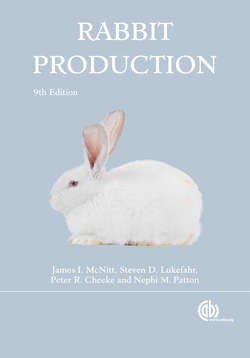Читать книгу Rabbit Production - James I McNitt - Страница 48
На сайте Литреса книга снята с продажи.
The Mating Process
ОглавлениеThe doe gives evidence of being receptive by behaving restlessly; by rubbing the chin (chinning) on the cage, water crock, feed troughs, etc.; and by making an effort to join other rabbits in nearby cages. The appearance of the vulva, whether it is pale or reddish in color, is generally indicative of the receptivity of the doe. A doe with a dry, pale vulva is less likely to be receptive than one with a pinkish-red, moist vulva.
The doe may object to another rabbit being placed in her cage and quite often will attack and even injure the intruder, so she should always be taken to the buck’s cage for mating. If the doe is ready for service and the buck is active, mating should occur almost immediately (Fig. 5.3). When it is completed the buck usually falls over on his side (Fig. 5.4). The buck’s ejaculation occasionally misses the vagina. If there is evidence of this, the doe should be bred again before being returned to her cage. Studies have shown that allowing the buck to breed the doe two or three times when first placed in the buck’s cage will increase the conception rate and perhaps the litter size. This may be due to the additional stimulation causing a stronger ovulatory response.
Fig. 5.3. An example of natural mating. (Courtesy of D.J. Harris)
Fig. 5.4. When mating is completed, the buck usually falls over on his side. (Courtesy of J.I. McNitt)
Sometimes a doe will squat in the corner of the cage and will not accept service; in this case, restraining her for mating may expedite and ensure service. This procedure makes many matings possible that would not occur otherwise. Restraining her, however, does not necessarily mean she will conceive. The conception rate from forced mating is much lower than from unrestrained mating.
Figure 5.5 shows the proper method for restraining the doe. Either the right or left hand is used to hold a fold of skin over the doe’s shoulders; the other hand is placed under her body and between her hind legs. The thumb is placed on one side of the vulva, the index finger on the other, and the skin is pushed gently backward while avoiding any pinching of the vagina. This procedure throws her tail up and over her back. The weight of the doe’s body is supported by the hand, and the rear quarters are elevated, but only to the normal height for mating. Bucks accustomed to being handled will not object to this assistance by the attendant, and many does will respond and accept service naturally when the buck mounts. Forced mating of rabbits should only be used as a last resort.
Fig. 5.5. Restraining a doe for mating. (Courtesy of D.J. Harris)
The buck and the doe should not be left together unattended for more than a few minutes, as the buck may be injured. If mating doesn’t occur within a few minutes, it is advisable to put the doe in with another buck. Sometimes she will refuse service with one buck but will readily accept it with another. If she still won’t breed, she is probably non-receptive for that day and should be rescheduled for the next day or the day after.
